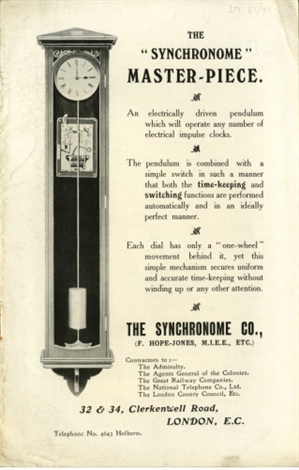Synchronome System and S.P Thompson

Frank Hope-Jones met George Bennett Bowell during their time at the Hope-Jones Organ Company. They discovered that they both had an interest in electromagnetism in clocks, an interest that led them to open the Synchronome Syndicate Limited in 1897. The company sold the ‘Synchronome System’, that was described in their 1899 pamphlet as:
‘…an electrically-driven pendulum, which is used to control any number of Dials. The pendulum is operated by two wheels only, and each dial by one. This simple mechanism suffices to secure uniform and accurate time-keeping, by all dials, without winding up or any other attention’.
Silvanus P. Thompson was consulted by the Synchronome Syndicate Limited, whose subsequent report was published in the same pamphlet. Thompson, who had a Synchronome system installed in his own home, was clearly impressed with it. Thompson noted the system’s advantages:
‘(I) In the controlling self-driven pendulum the excellent method of procuring the regular periodic electric contact without robbing any mechanical power by friction or otherwise from the driving mechanism of the clock; thereby ensuring absolutely uniform impulses independent of the strength of the electric current
(2) In the controlled dials the propulsion of the hands in perfect synchronism, by mechanism which is at once simple and secure’
Thompson also commented on his inspection of commercial installations of the Synchronome System which included the Institution of Mechanical Engineers – today only the mechanism remains as an object in the IMechE Archive. Thompson noted that ‘the dials distributed about the buildings in different rooms were in absolute agreement with one another’ and ended the report commending the system’s simplicity and reliability.
Despite the positive review, Bowell left the company in 1899 after the failed attempt to float the company on the London Stock Exchange. Nevertheless, Hope-Jones continued to operate the Synchronome Syndicate Limited until its liquidation in 1901; Hope-Jones would later establish the Synchronome Company Limited and produce the Synchronome-Shortt Free Pendulum, after meeting William Hamilton Shortt at the IEE in 1910. The Synchronome Company Limited continued to trade until 1962 when it was acquired by K. D. G. Instruments.
The S. P Thompson collection was deposited by his widow to the IEE in 1917. The pamphlets are available for consultation at the IET Archives; this has been made possible by the conservators and our volunteer who is currently cataloguing this rich and diverse pamphlet collection.
Please contact the IET Archives if you which to consult the S.P Thompson collection.
References
IET Library &Archives: UK0108 SPT/P/I/065 – Electric Clocks III
A History of Mechanical Inventions: Revised Edition, By Abbott Payson Usher page 317
Grace’s Guide to British Industrial History – Synchronome Company Limited